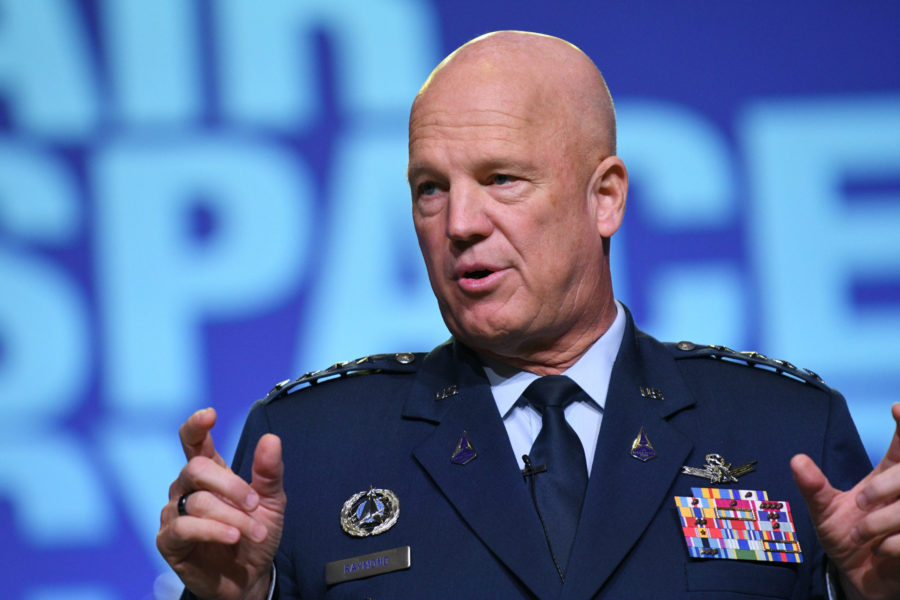Living in a hotel before he’d PCS’d to the D.C. region, Space Force Chief of Space Operations Gen. John W. “Jay” Raymond “was coming down the elevator” on the first morning he was authorized to wear his Operation Camouflage Pattern uniform with blue name tapes.
“A lady in the elevator looked at me, and she said, ‘You know, I don’t think I’ve ever met anybody in the Space Force before. I haven’t seen this uniform.’”
“I said, ‘Well, unless we’ve met, and unless we’ve met this morning—right before this—this is it. This is the first person,’” he said, recalling a time not so long ago when “there was absolutely one Guardian in the United States Space Force”—him.
But over the subsequent year and a half, the service has taken shape.
In addition to unveiling new uniforms Sept. 21, including a prototype service dress uniform and a PT uniform that’s being wear tested, Raymond’s update delivered at the Air Force Association’s Air, Space & Cyber Conference included:
Numbers of personnel
The Space Force is up to 6,490 Active-duty members, Raymond reported, with 86 Air Force Academy graduates having commissioned directly into the Space Force and officers otherwise commissioning “from every commissioning source there is,” Raymond said.
In December 2020, the service graduated its first seven enlisted members from Basic Military Training—part of the “broader Air Force BMT,” as Raymond put it, that enables the new service to “capitalize on that infrastructure that’s there.” Since then that number has grown to more than 500 graduates.
Meanwhile, Raymond said the Space Force admitted a Guardian with Type 1 diabetes, the first ever such direct accession into the U.S. military.
Revamping PME
The USSF has addressed professional military education courses from the bottom up.
“We started with Undergraduate Space Training—completely revamped that,” Raymond said, “shifted that from an unclassified course to a top secret course focused on the threat and training our operators to operate in the contested domain from Day 1.”
Raymond said the USSF has also updated its professional development courses at Airman Leadership School, the Noncommissioned Officer Academy, Squadron Officer School, Air Command and Staff College, and Air War College—“putting more space in the curriculum.” At the same time, the service continues to reorganize and create new courses specific to the Space Force, such as the new Space Fundamentals Course embedded in the Air Force Test Pilot School, which is on its third class.
Some courses were redesigned to have a classification allowing allies to take part, “and we’re already seeing that,” Raymond said.
Connecting communities
The Space Force also established the Space Warfighting Analysis Center that Raymond called “a small organization with PhD-level talent” which, “coupled with operators … have built a new force design for our first case—missile warning/missile tracking—and they have united the Department,” naming a number of Defense Department entities with a stake.
“Everybody’s rowing in the same direction,” Raymond said, predicting that the approach will “reduce duplication, reduce costs, and increase our ability to go fast.”
Meanwhile the Space Force became the 18th member of the Intelligence Community, which “allows us to strengthen the relationship with all of the intelligence agencies,” Raymond said. “Now we have an opportunity … to dig deeper on the threats that we’re seeing in the domain, to understand those threats more fully, and really begin to work on this thing called the National Space Intelligence Center,” another new initiative.
Absorbing missions
The Space Force will take over satellite programs from the Army and Navy as soon as the fiscal 2022 defense budget becomes law. The “first traunch,” or batch, of satellites to move over will include the Army Satellite Operations Brigade’s Wideband Global SATCOM, or WGS, and the Navy’s Ultra-High Band communications constellations and ground systems.
‘The Fight’
“We’re convinced that if deterrence were to fail, we’re going to have to fight and win the battlespace for superiority,” Raymond said. “That’s not going to be an easy fight. That’s a joint fight. That’s a fight that covers great distances. And that’s a fight that happens at incredible speeds—17,500 miles an hour, just to be in the fight.”
He referenced the robotic arm on a Chinese satellite—that “in the future could reach out and grab another satellite”—and a Russian “nesting doll” satellite that’s “a satellite inside a satellite inside a satellite.
“The satellite launches, opens up; another satellite comes out; it opens up; and a projectile is shot at a satellite—to destroy U.S. satellites and to destroy the advantages that that provides us,” Raymond emphasized, describing a theoretical scenario. “It destroys our ability to sense data from around the globe, to be able to bring that data down to Earth, be able to fuse that data with data from other domains.”
